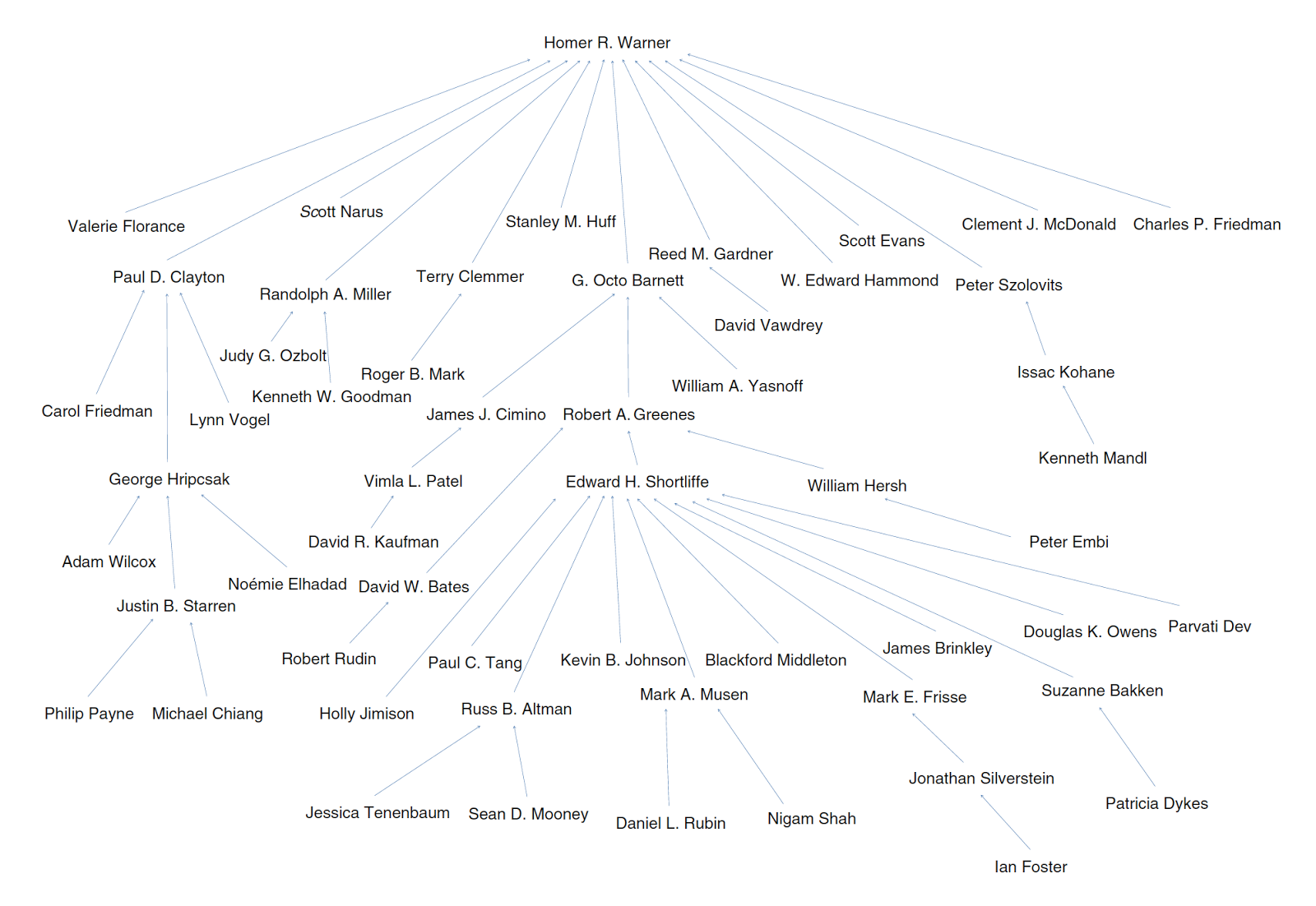 Book Publishing Certainly Has Changed
Book Publishing Certainly Has Changed
William Hersh, MD, Professor and Chair, OHSU
Blog: Informatics Professor
An article last fall in The New Republic noted that the book industry has not quite followed the music and film-camera industries in being disruptively innovated out of their traditional products [1]. Book publishing certainly has changed, but neither the decomposition of music albums into single songs has not happened with books, nor has the transition from a physical to digital medium undermined the basic economic model of books. Yes, the book industry has been transformed, particularly the role of brick-and-mortar booksellers. However, as this article points out, books themselves are still selling strong.
I have always been a book lover, one of those types who buys more books than he can possibly read. One can easily see this by walking into my work or home office, and finding the shelves lined with books. I run the gamut, from a small collection of antique medical books to rows of more recent volumes to those using the Kindle app (and other book apps) on my Mac, iPad, and iPhone.
I am also frequently asked to recommend textbooks in informatics. Certainly the most common, but not the only request is for an overview textbook. In recent years, that question comes qualified with “something I can use to study for the informatics board exam.” But I do get requests for books on other topics and used in other contexts.
The last few months have seen a flurry of new books on informatics topics. Not only brand new editions of venerable general texts, but the publishing of new topics as well. I even have chapters in some of these books. I would therefore like to take the rest of this post to the describe the recently updated books, my contributions to them, and other relevant specialty books.
When one thinks of the single most comprehensive book in the field, they are no doubt thinking about the “Shortliffe book” that, in its new fourth edition, is edited by Drs. Edward Shortliffe and James Cimino [2]. One of the challenges with what we also sometimes call “Ted’s book” is that the gap between editions has been longer than one might hope for in a rapidly advancing field. But the fourth edition is out now, and reflects the modern theory and practice of biomedical informatics. I have had a chapter in this book since the second edition on the topic of “Information Retrieval and Digital Libraries” [3].
This book went to press shortly after the death of an early legend of the informatics field, Dr. Homer Warner, of the University of Utah. This volume is dedicated to Homer, and there is a fascinating figure in the Preface that outlines the training descendants of all authors in the book, who can be traced back to Homer (including myself, through my fellowship mentor Dr. Robert Greenes, who in turn was mentored by Dr. Octo Barnett, who connected directly to Homer).
There is also another general book about the field that has come into its own through its now sixth edition, which is the volume edited by Dr. Robert Hoyt and Ann Yoshihashi [4]. This book has a more applied focus than the Shortliffe book, but has been an easy yet comprehensive read, especially in the gap between the third and fourth edition of the latter. Last year, when people wanted a single volume to prepare for the clinical informatics board exam, after advising people that one book could not cover the entire field in enough depth for the exam, I recommended Dr. Hoyt’s book as a starting point. For this year’s exam, of course, people will have updated versions of this book and Ted’s book from which to choose. I have two chapters in the Hoyt book, one solo-authored on healthcare data analytics [5] and a second on evidence-based medicine co-authored with Dr. Hoyt [6]. The book also has a Web site that provides additional materials and provides links to obtaining the book in various paper and electronic formats. The Web site also features a link to a PDF of my analytics chapter.
In addition to these two general books, there are many specialty books of note, some of which have just been published or refreshed with new editions. The following discussion is not exhaustive, but does cover books I believe are helpful in gaining knowledge about aspects of the field.
Among the new books are those from the Springer Health Informatics series, which is the largest single series of informatics books by any publisher. This series includes the Shortliffe book. There are a couple other new and noteworthy books in this series. One is on informatics education and is edited by Dr. Eta Berner [7]. The other is the second edition of the series’ volume on public health informatics, which is edited by Drs. JA Magnuson and Paul Fu [8]. In the Berner book, I have a couple chapters on the Office of the National Coordinator for Health IT (ONC) Workforce Development Program [9] and on the 10×10 (“ten by ten”) program [10]. In the Magnuson and Fu volume, I have a chapter that places public health informatics in the larger context of biomedical and health informatics [11].
This series also includes my own book about information retrieval (from 2009, in its third edition, and which has an associated Web site of updates and errata) [12] and a couple informative volumes about standards, one from Tim Benson focused on standards generally [13] and another from standards expert and OHSU student Keith Boone focused more specifically on Clinical Document Architecture [14].
Some other informatics books of note from other publishers include a volume on informatics methods [15], an online-only volume devoted to translational bioinformatics [16], and a text on pathology informatics [17]. The latter actually covers informatics beyond just pathology, so is almost a general textbook, and some of its content appeared to be present in questions on the recent clinical informatics subspecialty board exam.
Finally, another category of books worth noting is those devoted to explaining healthcare systems, particularly the US system. These books can be very valuable to those entering the informatics field without substantial clinical backgrounds. One book started as a primer written by a couple medical students, Elisabeth Askin and Nathan Moore, and provides a succinct overview of the US healthcare system [18]. The other book, written by journalist TR Reid, is an excellent comparative overview of the different approaches to healthcare systems around the world [19].
As I noted at the onset of this posting, books are still viable, and the informatics-related book-publishing enterprise is thriving. Books are still an important means of conveying bodies of knowledge, and I suspect will continue to be, even if the medium of them continues its transition from paper to electronic form.
References
- Hughes, E (2013). Books Don’t Want to Be Free – How publishing escaped the cruel fate of other culture industries. The New Republic, October 21, 2013, 22-24. http://www.newrepublic.com/article/115010/publishing-industry-thriving.
- Shortliffe, EH and Cimino, JJ, Eds. (2014). Biomedical Informatics: Computer Applications in Health Care and Biomedicine (Fourth Edition). London, England, Springer.
- Hersh, WR (2014). Information Retrieval and Digital Libraries. In Biomedical Informatics: Computer Applications in Health Care and Biomedicine (Fourth Edition). E. Shortliffe and J. Cimino. New York, NY, Springer: 613-641.
- Hoyt, RE and Yoshihashi, A, Eds. (2014). Health Informatics: Practical Guide for Healthcare and Information Technology Professionals, Sixth Edition. Pensacola, FL, Lulu.com.
- Hersh, WR (2014). Healthcare Data Analytics. In Health Informatics: Practical Guide for Healthcare and Information Technology Professionals, Sixth Edition. R. Hoyt and A. Yoshihashi. Pensacola, FL, Lulu.com.
- Hoyt, RE and Hersh, WR (2014). Evidence-Based Medicine & Clinical Practice Guidelines. In Health Informatics: Practical Guide for Healthcare and Information Technology Professionals, Sixth Edition. R. Hoyt and A. Yoshihashi. Pensacola, FL, Lulu.com: 323-350.
- Berner, E, Ed. (2014). Informatics Education in Healthcare: Lessons Learned. London, England, Springer.
- Magnuson, JA and Fu, PC (2014). Public Health Informatics and Information Systems. New York, NY, Springer.
- Hersh, WR (2014). Informatics for the Health Information Technology Workforce. In Informatics Education in Healthcare: Lessons Learned. E. Berner. London, England, Springer: 93-107.
- Hersh, WR (2014). Online Continuing Education in Informatics: The AMIA 10 × 10 Experience. In Informatics Education in Healthcare: Lessons Learned. E. Berner. London, England, Springer: 109-120.
- Hersh, WR (2014). Context and Value of Biomedical and Health Informatics. In Public Health Informatics and Information Systems. J. Magnuson and P. Fu. New York, NY, Springer: 37-46.
- Hersh, WR (2009). Information Retrieval: A Health and Biomedical Perspective (3rd Edition). New York, NY, Springer.
- Benson, T (2012). Principles of Health Interoperability HL7 and SNOMED (Health Information Technology Standards), Second Edition. New York, NY, Springer.
- Boone, KW (2011). The CDA Book. New York, NY, Springer.
- Sarkar, IN (2014). Methods in Biomedical Informatics: A Pragmatic Approach. London, England, Academic Press.
- Kann, M and Lewitter, F, Eds. (2013). Translational Bioinformatics. San Francisco, CA, Public Library of Science. http://www.ploscollections.org/translationalbioinformatics.
- Pantanowitz, L, Tuthill, JM, et al., Eds. (2011). Pathology Informatics: Theory and Practice. Chicago, IL, American Society for Clinical Pathology.
- Askin, E (2012). The Health Care Handbook. St. Louis, MO, Washington University School of Medicine.
- Reid, TR (2010). The Healing of America: A Global Quest for Better, Cheaper, and Fairer Health Care. New York, NY, Penguin Books.
This article post first appeared on The Informatics Professor. Dr. Hersh is a frequent contributing expert to HITECH Answers.

